Revisiting the Evolution of Multi-Scale Structures of Starches with Different Crystalline Structures During Enzymatic Digestion
Abstract
1. Introduction
2. Materials and Methods
2.1. Materials
2.2. Digestion of Starch Granules
2.3. Analysis of Granular Features of Starch Granules
2.4. Analysis of Lamellar Structure of Starch Granules
2.5. Analysis of Crystalline Structure of Starches
2.6. Analysis of Ordered Molecular Structure of Starch Granules
2.7. Analysis of Degree of Branching of Starch Granules
2.8. Analysis of Molecular Structures of Starch Granules
2.9. Statistical Analysis
3. Results and Discussion
3.1. Morphology and Particle Size of Starches
3.2. Lamellar Structures of Starches
3.3. Crystalline Structures of Starches
3.4. Ordered Molecular Structures of Starches
3.5. Degree of Branching of Starches
3.6. Chromatographic Analysis of the Molecular Weight
3.7. Molecular Distribution of Starches
3.8. Short Discussion
4. Conclusions
Supplementary Materials
Author Contributions
Funding
Data Availability Statement
Conflicts of Interest
References
- Ziaud, D.; Xiong, H.; Fei, P. Physical and chemical modification of starches: A review. Crit. Rev. Food Sci. 2017, 57, 2691–2705. [Google Scholar] [CrossRef] [PubMed]
- Zhong, Y.; Xu, J.; Liu, X.; Ding, L.; Svensson, B.; Herburger, K.; Guo, K.; Pang, C.; Blennow, A. Recent advances in enzyme biotechnology on modifying gelatinized and granular starch. Trends Food Sci. Technol. 2022, 123, 343–354. [Google Scholar] [CrossRef]
- Maniglia, B.C.; Castanha, N.; Le-Bail, P.; Le-Bail, A.; Augusto, P.E.D. Starch modification through environmentally friendly alternatives: A review. Crit. Rev. Food Sci. 2021, 61, 2482–2505. [Google Scholar] [CrossRef]
- Guo, L.; Li, J.; Gui, Y.; Zhu, Y.; Yu, B.; Tan, C.; Fang, Y.; Cui, B. Porous starches modified with double enzymes: Structure and adsorption properties. Int. J. Biol. Macromol. 2020, 164, 1758–1765. [Google Scholar] [CrossRef]
- Guo, L.; Li, J.; Yuan, Y.; Gui, Y.; Zou, F.; Lu, L.; Cui, B. Structural and functional modification of kudzu starch using α-amylase and transglucosidase. Int. J. Biol. Macromol. 2021, 169, 67–74. [Google Scholar] [CrossRef]
- Dura, A.; Błaszczak, W.; Rosell, C.M. Functionality of porous starch obtained by amylase or amyloglucosidase treatments. Carbohydr. Polym. 2014, 101, 837–845. [Google Scholar] [CrossRef]
- Guo, L.; Tao, H.; Cui, B.; Janaswamy, S. The effects of sequential enzyme modifications on structural and physicochemical properties of sweet potato starch granules. Food Chem. 2019, 277, 504–514. [Google Scholar] [CrossRef]
- Wang, S.; Dhital, S.; Wang, K.; Fu, X.; Zhang, B.; Huang, Q. Side-by-side and exo-pitting degradation mechanism revealed from in vitro human fecal fermentation of granular starches. Carbohydr. Polym. 2021, 263, 118003. [Google Scholar] [CrossRef] [PubMed]
- Shrestha, A.K.; Blazek, J.; Flanagan, B.M.; Dhital, S.; Larroque, O.; Morell, M.K.; Gilbert, E.P.; Gidley, M.J. Molecular, mesoscopic and microscopic structure evolution during amylase digestion of maize starch granules. Carbohydr. Polym. 2012, 90, 23–33. [Google Scholar] [CrossRef]
- Xu, X.; Chen, Y.; Luo, Z.; Lu, X. Different variations in structures of A- and B-type starches subjected to microwave treatment and their relationships with digestibility. LWT-Food Sci. Technol. 2019, 99, 179–187. [Google Scholar] [CrossRef]
- Chen, J.; Liang, Y.; Li, X.; Chen, L.; Xie, F. Supramolecular structure of jackfruit seed starch and its relationship with digestibility and physicochemical properties. Carbohydr. Polym. 2016, 150, 269–277. [Google Scholar] [CrossRef] [PubMed]
- Englyst, H.N.; Kingman, S.; Cummings, J. Classification and measurement of nutritionally important starch fractions. Eur. J. Clin. Nutr. 1992, 46, S33–S50. [Google Scholar] [PubMed]
- Wang, H.; Zhang, X.; Peng, S.; Liu, X.; Zhang, H.; Zhang, Y. Controlling the digestibility and multi-level structure of waxy rice starch by complexation with Artemisia sphaerocephala Kracsh Gum. Food Hydrocoll. 2023, 145, 109149. [Google Scholar] [CrossRef]
- Chi, C.; Li, X.; Lu, P.; Miao, S.; Zhang, Y.; Chen, L. Dry heating and annealing treatment synergistically modulate starch structure and digestibility. Int. J. Biol. Macromol. 2019, 137, 554–561. [Google Scholar] [CrossRef]
- Wang, H.; Wang, Y.; Wang, R.; Liu, X.; Zhang, Y.; Zhang, H.; Chi, C. Impact of long-term storage on multi-scale structures and physicochemical properties of starch isolated from rice grains. Food Hydrocoll. 2022, 124, 107255. [Google Scholar] [CrossRef]
- Xu, K.; Chi, C.; She, Z.; Liu, X.; Zhang, Y.; Wang, H.; Zhang, H. Understanding how starch constituent in frozen dough following freezing-thawing treatment affected quality of steamed bread. Food Chem. 2022, 366, 130614. [Google Scholar] [CrossRef]
- Wang, H.; Wang, Y.; Xu, K.; Zhang, Y.; Shi, M.; Liu, X.; Chi, C.; Zhang, H. Causal relations among starch hierarchical structure and physicochemical characteristics after repeated freezing-thawing. Food Hydrocoll. 2022, 122, 107121. [Google Scholar] [CrossRef]
- Nilsson, G.S.; Sc, B.; Gorton, L. Determination of the degree of branching in normal and amylopectin type potato starch with 1H-NMR spectroscopy improved resolution and two-dimensional spectroscopy. Starch-Stärke 1996, 48, 352–357. [Google Scholar] [CrossRef]
- Chi, C.; Yang, Y.; Li, S.; Shen, X.; Wang, M.; Zhang, Y.; Zheng, X.; Weng, L. Starch intrinsic crystals affected the changes of starch structures and digestibility during microwave heat-moisture treatment. Int. J. Biol. Macromol. 2023, 240, 124297. [Google Scholar] [CrossRef]
- Vilaplana, F.; Hasjim, J.; Gilbert, R.G. Amylose content in starches: Toward optimal definition and validating experimental methods. Carbohydr. Polym. 2012, 88, 103–111. [Google Scholar] [CrossRef]
- Qiao, D.; Xie, F.; Zhang, B.; Zou, W.; Zhao, S.; Niu, M.; Lv, R.; Cheng, Q.; Jiang, F.; Zhu, J. A further understanding of the multi-scale supramolecular structure and digestion rate of waxy starch. Food Hydrocoll. 2016, 65, 24–34. [Google Scholar] [CrossRef]
- Chi, C.; Ren, W.; Yang, Y.; Guo, X.; Zhang, Y.; Chen, B.; He, Y.; Chen, H.; Zheng, X.; Wang, H. Starch ordered structures control starch reassembly behaviors during heat–moisture treatment for modulating its digestibility. Food Chem. 2024, 430, 136966. [Google Scholar] [CrossRef] [PubMed]
- Dhital, S.; Warren, F.J.; Butterworth, P.J.; Ellis, P.R.; Gidley, M.J. Mechanisms of starch digestion by α-amylase—Structural basis for kinetic properties. Crit. Rev. Food Sci. 2015, 57, 875–892. [Google Scholar] [CrossRef] [PubMed]
- Teng, A.; Witt, T.; Wang, K.; Li, M.; Hasjim, J. Molecular rearrangement of waxy and normal maize starch granules during in vitro digestion. Carbohydr. Polym. 2016, 139, 10–19. [Google Scholar] [CrossRef] [PubMed]
- Zhao, Y.; Henry, R.J.; Gilbert, R.G. Starch structure-property relations in Australian wild rices compared to domesticated rices. Carbohydr. Polym. 2021, 271, 118412. [Google Scholar] [CrossRef] [PubMed]
- Wang, S.; Copeland, L. Molecular disassembly of starch granules during gelatinization and its effect on starch digestibility: A review. Food Funct. 2013, 4, 1564–1580. [Google Scholar] [CrossRef] [PubMed]
- Jane, J.L.; Wong, K.S.; McPherson, A.E. Branch-structure difference in starches of A-and B-type X-ray patterns revealed by their Naegeli dextrins. Carbohydr. Res. 1997, 300, 219–227. [Google Scholar] [CrossRef]
- Wang, H.W.; Zhang, B.J.; Chen, L.; Li, X.X. Understanding the structure and digestibility of heat-moisture treated starch. Int. J. Biol. Macromol. 2016, 88, 1–8. [Google Scholar] [CrossRef]
- Chi, C.; Li, X.; Huang, S.; Chen, L.; Zhang, Y.; Li, L.; Miao, S. Basic principles in starch multi-scale structuration to mitigate digestibility: A review. Trends Food Sci. Technol. 2021, 109, 154–168. [Google Scholar] [CrossRef]
- Gonzalez, A.; Wang, Y.J. Enhancing the formation of porous potato starch by combining α-amylase or glucoamylase digestion with acid hydrolysis. Starch-Stärke 2020, 72, 1900269. [Google Scholar] [CrossRef]
- Sun, C.; Wei, Z.; Xue, C.; Yang, L. Development, application and future trends of starch-based delivery systems for nutraceuticals: A review. Carbohydr. Polym. 2023, 308, 120675. [Google Scholar] [CrossRef] [PubMed]
- Zhang, Y.; Chi, C.; Huang, X.; Zou, Q.; Li, X.; Chen, L. Starch-based nanocapsules fabricated through layer-by-layer assembly for oral delivery of protein to lower gastrointestinal tract. Carbohydr. Polym. 2017, 171, 242–251. [Google Scholar] [CrossRef] [PubMed]
- Zhang, Y.; Zhong, S.; Chi, C.; He, Y.; Li, X.; Chen, L.; Miao, S. Tailoring assembly behavior of starches to control insulin release from layer-by-layer assembled colloidal particles. Int. J. Biol. Macromol. 2020, 160, 531–537. [Google Scholar] [CrossRef] [PubMed]
- Hou, H.; Chi, C.; Wang, T.; He, Y.; Chen, L.; Li, X. Multi-responsive starch-based nanocapsules for colon-targeting delivery of peptides: In vitro and in vivo evaluation. Int. J. Biol. Macromol. 2023, 242, 124953. [Google Scholar] [CrossRef] [PubMed]
- Shi, P.; Zhao, Y.; Qin, F.; Liu, K.; Wang, H. Understanding the multi-scale structure and physicochemical properties of millet starch with varied amylose content. Food Chem. 2023, 410, 135422. [Google Scholar] [CrossRef]
- Jeong, S.; Kim, Y.; Ko, S.; Yoon, M.-R.; Lee, J.-S.; Lee, S. Physicochemical characterization and in-vitro digestibility of extruded rice noodles with different amylose contents based on rheological approaches. J. Cereal Sci. 2016, 71, 258–263. [Google Scholar] [CrossRef]
- Jeong, S.; Kim, M.; Yoon, M.-R.; Lee, S. Preparation and characterization of gluten-free sheeted doughs and noodles with zein and rice flour containing different amylose contents. J. Cereal Sci. 2017, 75, 138–142. [Google Scholar] [CrossRef]
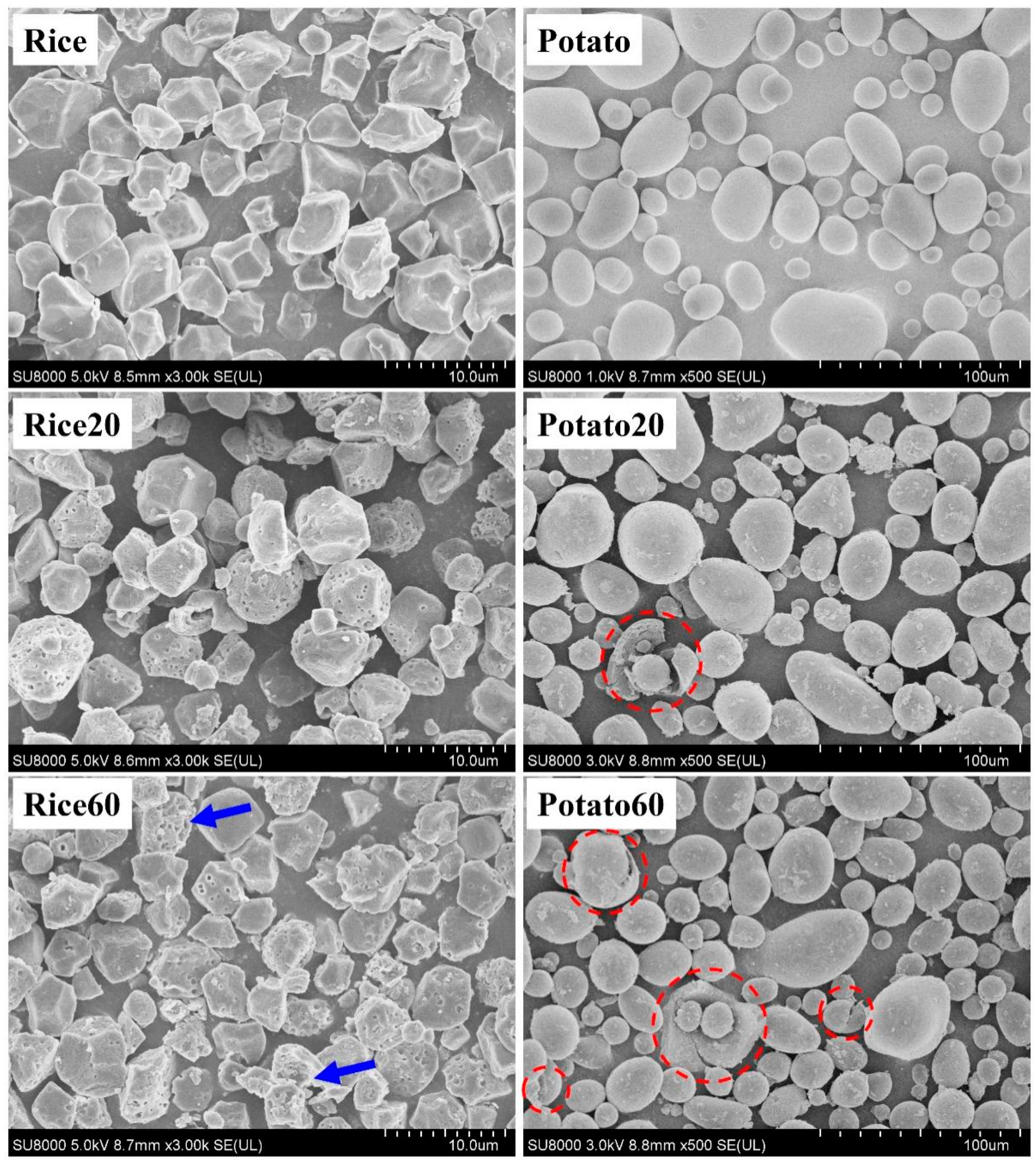
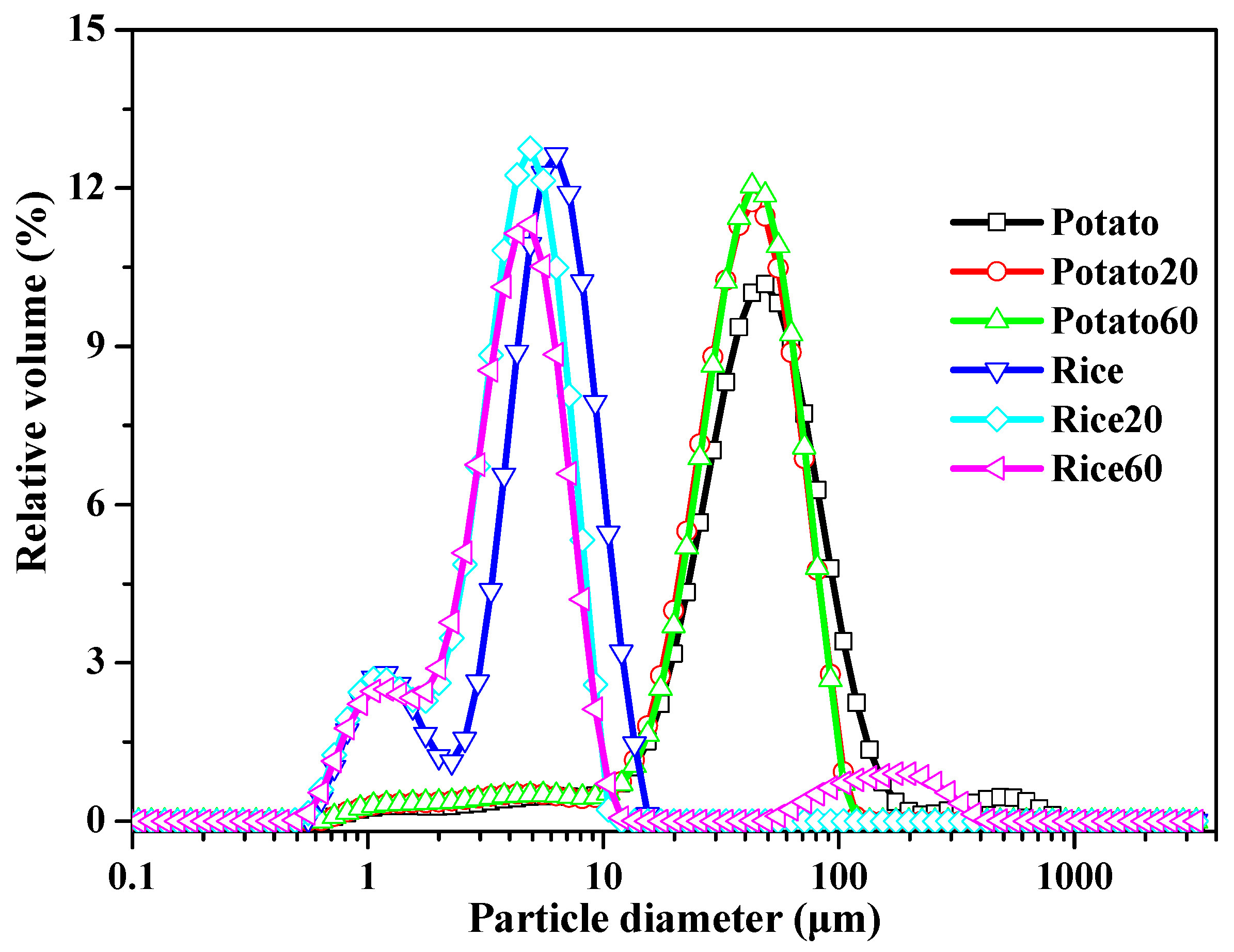
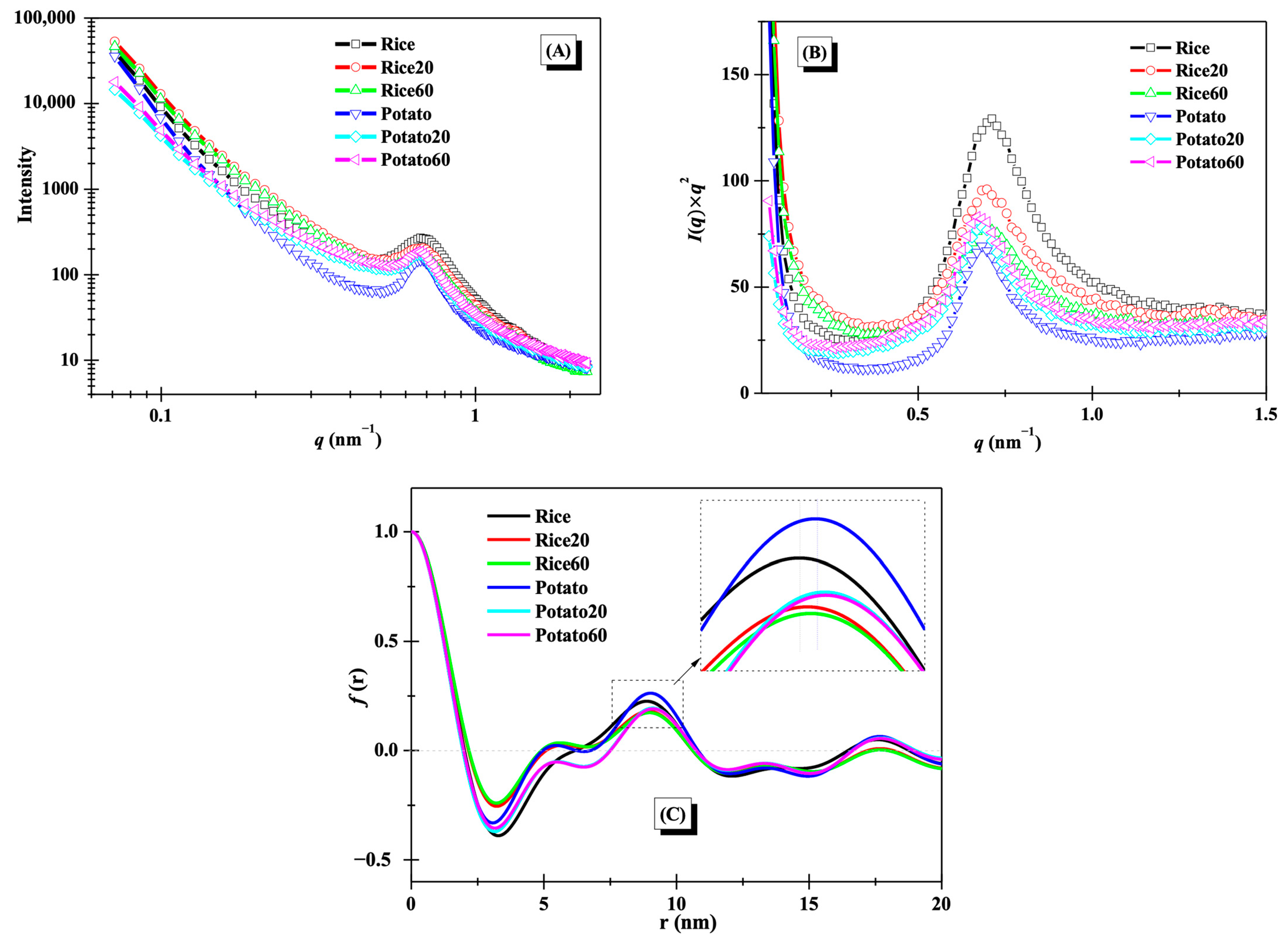
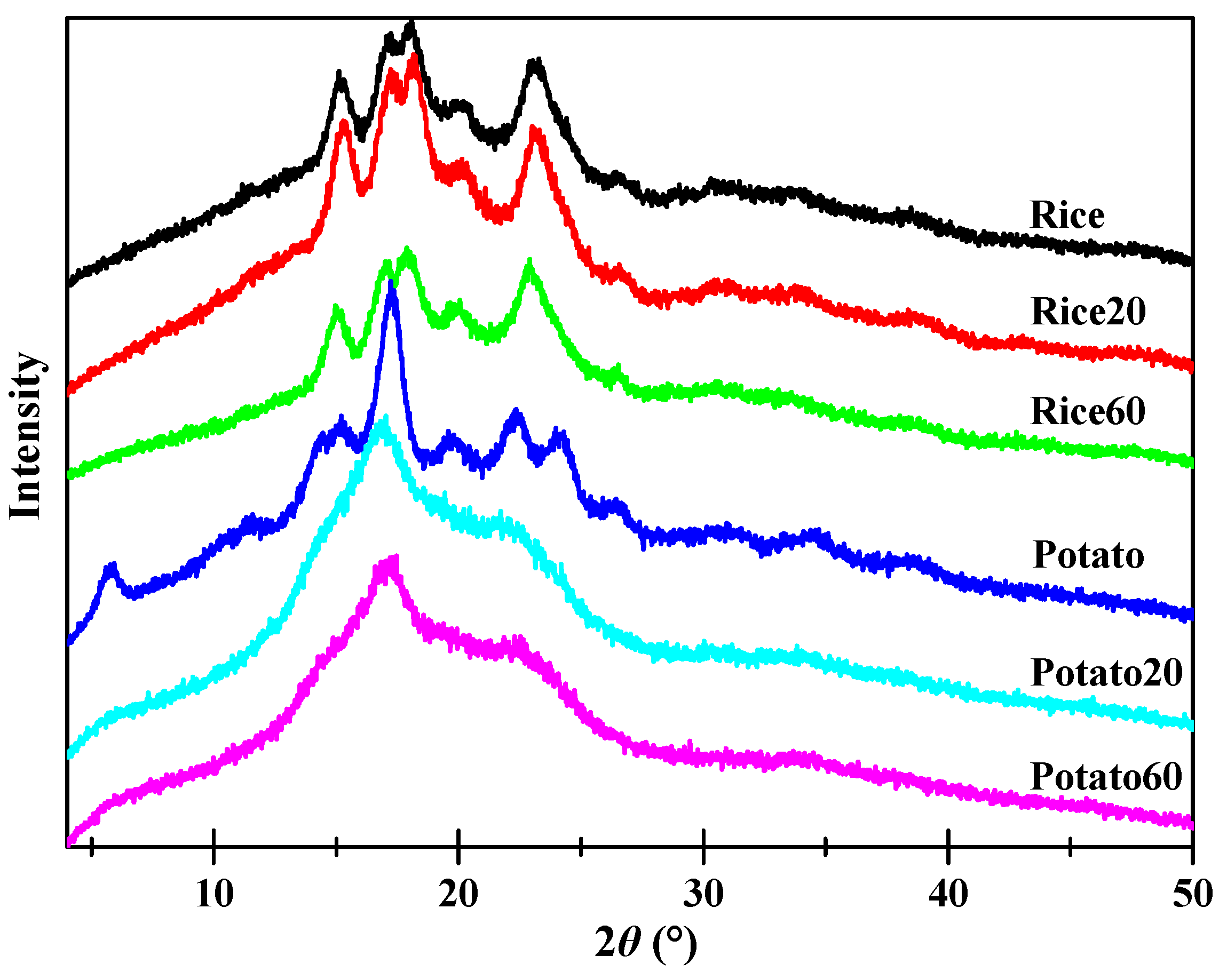
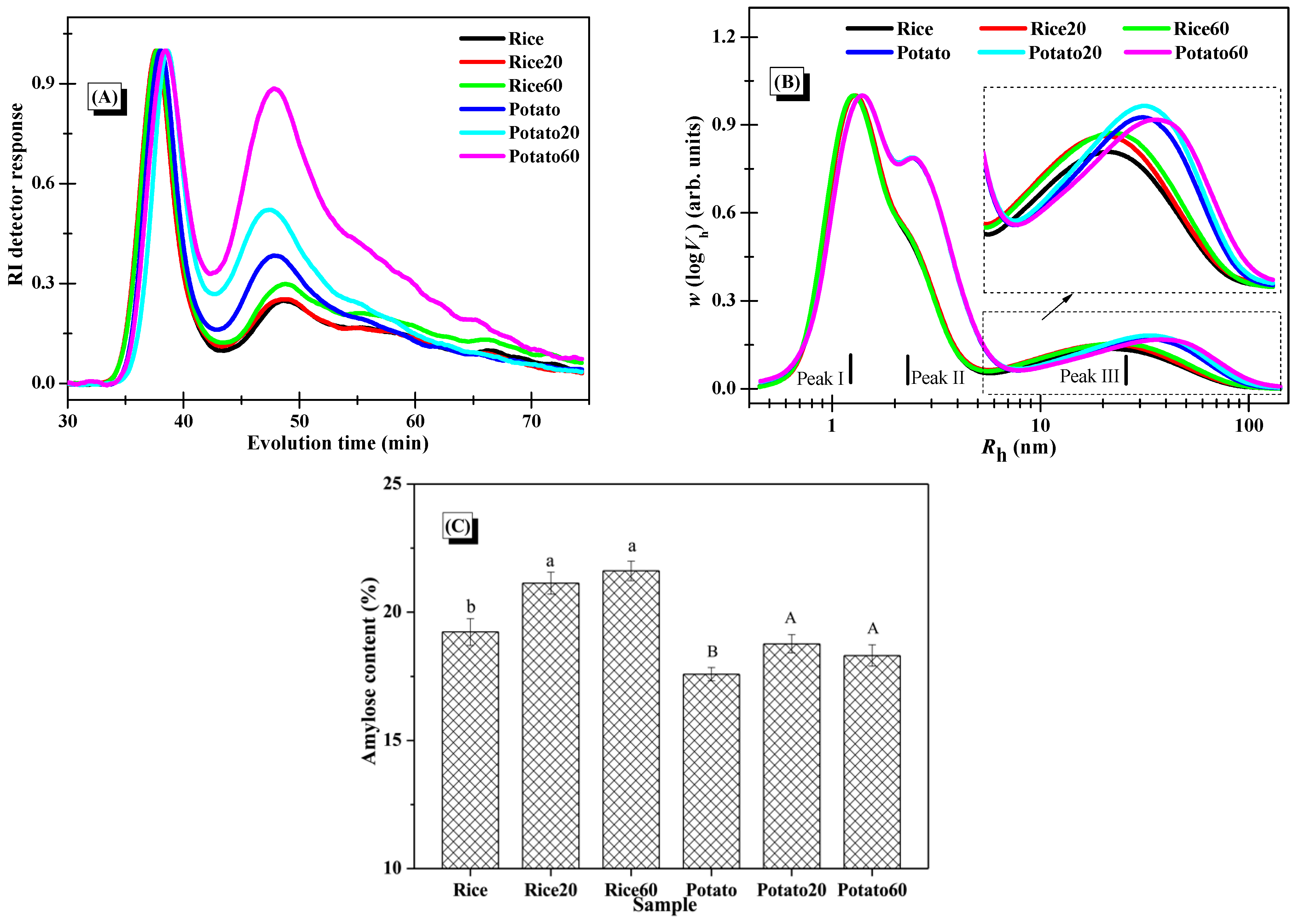
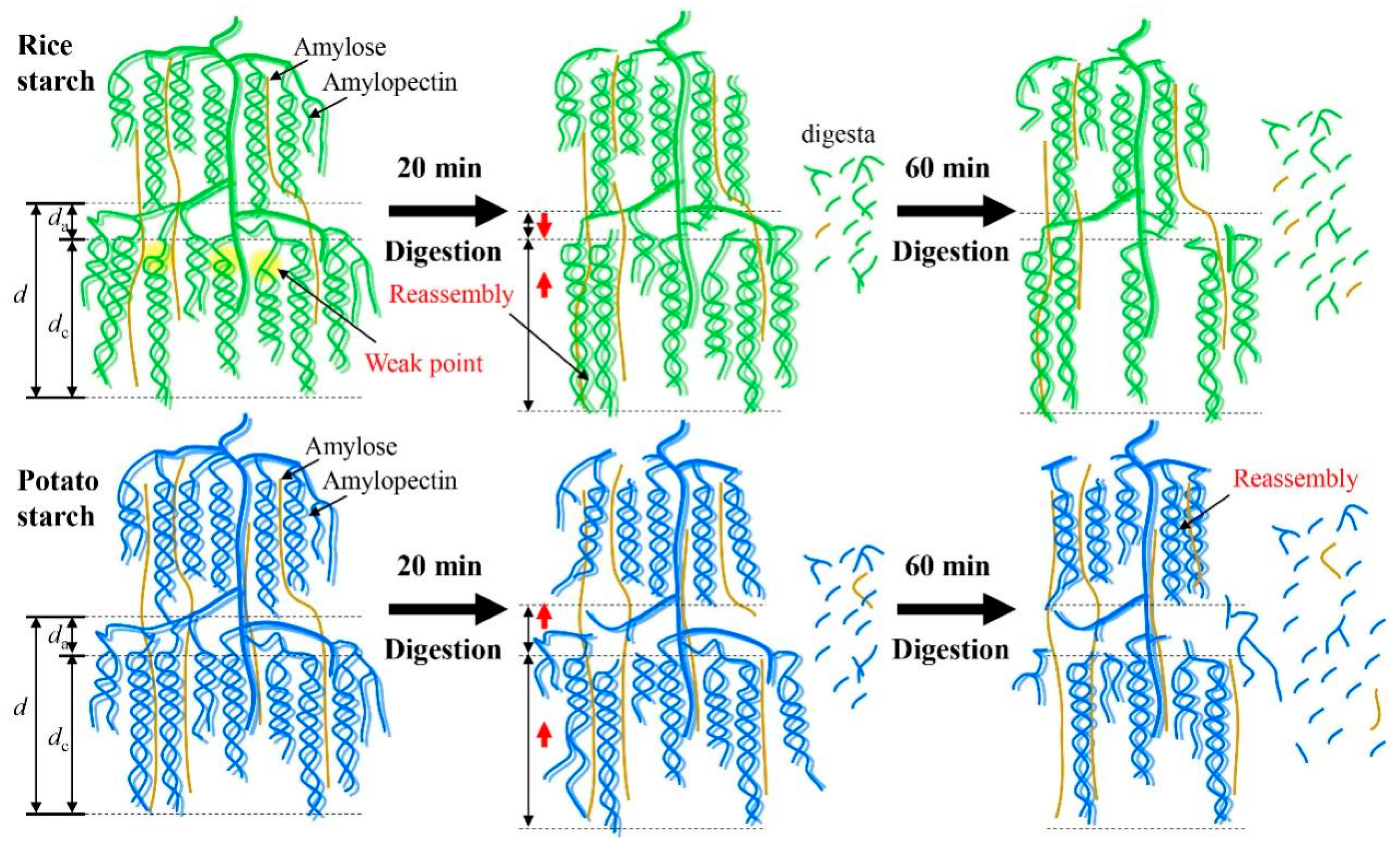
| Sample | d (nm) | da (nm) | dc (nm) | RC (%) |
|---|---|---|---|---|
| Rice | 8.88 ± 0.01 b | 2.58 ± 0.01 a | 6.30 ± 0.01 b | 18.87 ± 0.47 b |
| Rice20 | 8.95 ± 0.02 a | 2.53 ± 0.01 b | 6.42 ± 0.02 a | 19.80 ± 0.36 a |
| Rice60 | 8.98 ± 0.01 a | 2.52 ± 0.01 b | 6.46 ± 0.01 a | 17.43 ± 0.21 c |
| Potato | 9.02 ± 0.01 B | 2.44 ± 0.01 B | 6.58 ± 0.01 B | 18.97 ± 0.25 A |
| Potato20 | 9.11 ± 0.01 A | 2.48 ± 0.01 A | 6.63 ± 0.01 A | 16.23 ± 0.21 B |
| Potato60 | 9.12 ± 0.02 A | 2.48 ± 0.01 A | 6.63 ± 0.02 A | 15.27 ± 0.15 C |
| Sample | To (°C) | Tp (°C) | Te (°C) | △H (J/g) | DB (%) | Mw (×106 Da) |
|---|---|---|---|---|---|---|
| Rice | 63.68 ± 0.09 b | 68.61 ± 0.42 b | 75.67 ± 0.35 b | 9.15 ± 0.94 a | 6.64 ± 0.15 c | 163.10 ± 0.52 a |
| Rice20 | 68.44 ± 0.10 a | 72.83 ± 0.17 a | 81.20 ± 0.15 a | 5.53 ± 0.22 b | 7.27 ± 0.12 b | 161.26 ± 0.50 b |
| Rice60 | 68.81 ± 0.20 a | 74.25 ± 1.53 a | 81.83 ± 1.75 a | 5.95 ± 0.25 b | 7.76 ± 0.13 a | 125.65 ± 0.38 c |
| Potato | 61.82 ± 0.02 A | 65.78 ± 0.09 A | 71.69 ± 0.62 A | 13.37 ± 0.89 A | 5.43 ± 0.09 C | 91.30 ± 0.23 A |
| Potato20 | 55.82 ± 0.33 C | 62.17 ± 0.42 B | 71.80 ± 0.36 A | 10.30 ± 0.48 B | 5.74 ± 0.13 B | 59.75 ± 0.12 B |
| Potato60 | 57.41 ± 0.29 B | 62.34 ± 0.23 B | 71.16 ± 0.04 A | 5.45 ± 0.26 C | 5.96 ± 0.01 A | 52.11 ± 0.10 C |
Disclaimer/Publisher’s Note: The statements, opinions and data contained in all publications are solely those of the individual author(s) and contributor(s) and not of MDPI and/or the editor(s). MDPI and/or the editor(s) disclaim responsibility for any injury to people or property resulting from any ideas, methods, instructions or products referred to in the content. |
© 2024 by the authors. Licensee MDPI, Basel, Switzerland. This article is an open access article distributed under the terms and conditions of the Creative Commons Attribution (CC BY) license (https://creativecommons.org/licenses/by/4.0/).
Share and Cite
Chen, S.; Qiu, Z.; Yang, Y.; Wu, J.; Jiao, W.; Chen, Y.; Jin, C. Revisiting the Evolution of Multi-Scale Structures of Starches with Different Crystalline Structures During Enzymatic Digestion. Foods 2024, 13, 3291. https://doi.org/10.3390/foods13203291
Chen S, Qiu Z, Yang Y, Wu J, Jiao W, Chen Y, Jin C. Revisiting the Evolution of Multi-Scale Structures of Starches with Different Crystalline Structures During Enzymatic Digestion. Foods. 2024; 13(20):3291. https://doi.org/10.3390/foods13203291
Chicago/Turabian StyleChen, Simin, Zihui Qiu, Ying Yang, Jianfeng Wu, Wenjuan Jiao, Ying Chen, and Chengzhi Jin. 2024. "Revisiting the Evolution of Multi-Scale Structures of Starches with Different Crystalline Structures During Enzymatic Digestion" Foods 13, no. 20: 3291. https://doi.org/10.3390/foods13203291
APA StyleChen, S., Qiu, Z., Yang, Y., Wu, J., Jiao, W., Chen, Y., & Jin, C. (2024). Revisiting the Evolution of Multi-Scale Structures of Starches with Different Crystalline Structures During Enzymatic Digestion. Foods, 13(20), 3291. https://doi.org/10.3390/foods13203291







